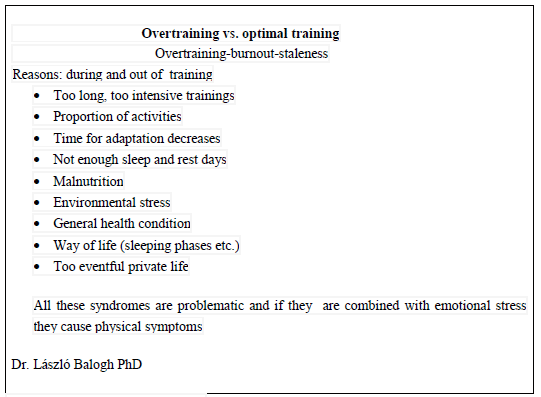The psychic causes and consequences of overtraining
It is known that our body is capable of adaptation if the quality and quantity of trainings are appropriate. This phase is considered the developmental one.
The addition of stimuli decides if there is development. It will not happen if stimuli are either too few or too many. Too many can be harmful expect for resting. It degrades athletes’ performance and it can have long-lasting and serious psychological consequences.
Cashmore (2008) defines this phenomenon as OTS-overtraining syndrome. Its syndromes are the followings: exhaustion, staleness, weakened immune system, loss of body weight, loss of muscle mass, vulnerability, touchy and controlling motive action.

Figure 24. Reasons for over-training
Read more about the addisonoid and basedovoid overtraining syndromes here.
http://www.trinfo.hu/felkeszules/edzeselmelet/basedovoid-es-addizonoid- tuledzettseg/
Overtraining is in connection with burn-out syndrome. See the following websites:
http://www.webbeteg.hu/cikkek/psziches/3284/a-kieges--%28burnout%29-szindroma
http://hu.wikipedia.org/wiki/Ki%C3%A9g%C3%A9si_szindr%C3%B3ma
To avoid overtraining professional planning can help as well as giving opportunity to have enough time to rest and sleep, offering manifold stimuli, checking the athletes’ diet and evaluating the athletes’ both verbal and non-verbal feedbacks. It is always easier to avoid over-training than to deal with its physical and psychological consequences.

Figure 25. Treating over-training
The psychological questions of choosing sports10
What kind of criteria should be taken into consideration when choosing sports? And is it the parents, their children or the PE teacher who choose sports?
Ideally children opt for sports, but very often they are influenced by the social, educational and family environment. Their friends have already tried that sport, saw it on TV, they became fond of it, tried out at PE classes and their parents also did some sports. If sports are chosen by inner motivation it can be considered really ideal.
Children should like and enjoy what they do. Thus they commit themselves to sports and physical activities and they may become world class athletes later in their career. They have to endure lots of strains and hardships. They cannot help experiencing that sometimes they are behind success, get injured and very likely the first years of success support the endurance of their failures.
Naturally children may come to like the sport they have not opted for “on their own account”. There are examples of successful athletes and “hyperactive” children whose physician suggested doing physical activities. One thing is sure, if parents want to fulfil their desires through making their children do sports it is predictable that these children will be unsuccessful athletes. However hard it is for parents they must accept this often experienced fact. Children being emotionally blackmailed and with low inner motivation will never have long and successful sport careers.
The question is often raised whether children should choose individual or team sports, or ball games. It has been experienced that a child who tried out several different sports and having movement culture independently of the sports he/she practised he/she achieved a minimum good level. It can be stated that the more sports a child tries out the more chance he/she will achieve some result.
Both parents and PE teachers know children so well that they can decide if they are able to play in a community, put up with monotony and have the courage to fight. All these can be measured by different tests. But in case of 6-12 year old children the collected data cannot be easily assessed and the outcomes do not substitute parents’ experience.
When children should be suggested starting doing sports is another serious question. There are sports which are worth doing at an earlier age but these sports careers will end up sooner than in case of children aged 12-14. Our responsibility is to decide how children’s childhood could be secured when they are expected to work long hours within a high achievement system. Therefore who chose gymnastic, swimming or tennis they must prepare for these hardships. Within these sports burn-out syndrome is frequent. It is not easy to balance between serious expectations and requirements and letting children enjoy their childhood.
Nagykáldi, (1998) describes the profiles of sports. Based on these data athletes’ qualities can be detected and evaluated. In sports, such as, sponge handball, basketball kangaroo cup both girls and boys attend, thus they can experience what it is like to play in a community. Individual athletes also have the chance to work in a community where sports dynamics is present.
It is a crucial question if the chosen sports are appropriate for sportsman’s/sportswomen’s abilities and competences. It is already known that doing team sports it supports athletes to work with others and help their team mates. Whereas an individual athlete may become “egocentric”.
It can be concluded that athletes should be fond of what they do and insist on continuing their work even if they fail. The opted sports should be in harmony with their personality and help their future career. Parents and PE teachers must not force children to do activities and make them achieve high results on all cost. Parents’ responsibility is to trust their children and maintain a harmonious and creative atmosphere around them. Sometimes competitive sports are demanding and cruel therefore we must not forget about that athletes are not machines. Our most important task is to keep control on trainings and to educate healthy grown-ups mentally and physically.
[10] In the book of Andor Molnár we can read more about the physiological effects of choosing sports.